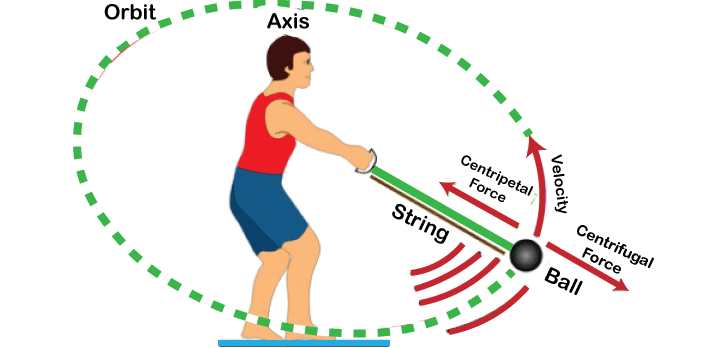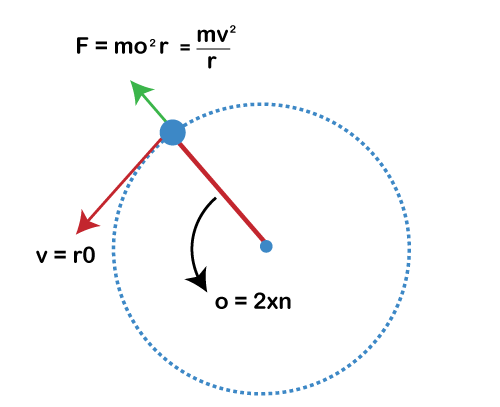Centrifugal Force DefinitionThe perceived outward force that a rotating mass experiences is known as centrifugal force. The centrifugal force, which seems to operate on all entities when viewed from a reference point that rotates, is an inertial force, sometimes known as a "fictitious" or "fake" force in Newtonian physics. It is pointed away from the coordinate system's origin along an axis parallel to the center of rotation. When the rotational line coincides with the coordinate system's origin, centrifugal force is generated radially outward from that point. The following equations can be used to determine how much centrifugal pulling force 'F' will act on an object of mass "m" when it is positioned "r" distance from the beginning of a frame that rotates of reference: F=mw2r Where, F = centrifugal force m = mass w = angular velocity r = distance from the origin 
Meaning of Centrifugal ForceA revolving reference frame will show the outward force known as centrifugal force. An object does not exist when a structure is characterized as an "inertial reference framework". Every measurement of location and speed needs to be conducted in relation to another object. For instance, it is possible to analyze an object's motion in relation to the airplane, the Earth's surface, or even the Sun as it is in flight. Inertial frames are frames of reference that are at rest in relation to "fixed stars." (or one that moves with no revolution and constant speed). Any system is amenable to an inertial frame study. Yet, employing a rotating frame to explain a rotating system is frequently more practical because the computations are easier and the explanations are clearer. This decision results in the emergence of imaginary forces, such as the centrifugal force. Regardless of their states of motion, all objects in a reference frame that is revolving about an axis via its point of origin seem to be vulnerable to an outward force that proportional to their weight, to the proximity to the axis of rotation, and to the square of the point's angular momentum. This is the centrifugal force at work. Centripetal force is less well-known than centrifugal force because it is more common for people to feel it when they are inside a rotating reference frame, like on a car or merry-go-round. HistoryIn the notebooks and writings of Christiaan Huygens, the term "vi centrifuga" (Latin for "centrifugal force") dates back to 1659. Keep in mind that in Latin, fugus (from fungi) means "fleeing, avoiding," and centrum means "center". Hence, the exact translation of centrifugus is "fleeing from the center". In 1673, Huygens wrote the following (as transcribed by Richard J. Blackwell) in Horologium Oscillatorium: "In addition to the oscillation we have looked at so far, there is another type of oscillation: a motion where a suspended weight is moved around the circumference of a circle. We followed this up by building a second clock simultaneously as we created the first one. I had originally planned to provide a comprehensive description of these clocks as well as information regarding circular motion & centrifugal force, or whatever you want to call it; I have a lot to say on this subject, but I'm not in a position to do so at the moment. So, contrary to my original idea, I've added this fifth section so that individuals interested in these matters might sooner enjoy these fresh and not pointless hypotheses and that their release won't be delayed by accident." The "vis centrifuga" ("centrifugal force") was further developed by Newton in Principia in 1687. During this period, Robert Hooke, Gottfried Wilhelm Leibniz, & Isaac Newton all made improvements to the idea. The contemporary understanding of the centrifugal force emerged as a "fictitious force" in a rotating reference in the late 18th century. Discussions about detecting absolute mobility in classical mechanics have also involved centrifugal force. Newton proposed the rotating bucket and rotating spheres arguments to address the issue of whether perfect rotation can be detected. According to Newton, the centrifugal force would only be evident in the object's local framework if it revolved with respect to absolute space in each instance. Applications of Centrifugal ForceCentrifugal force makes it easiest to understand how many typical spinning mechanical systems operate. For instance:
The study of forces and motions inside the system must be done more cautiously. Still, it is possible to characterize each of these systems without using the concept of centrifugal force by describing motions and forces in a fixed frame. 
ExamplesStone strung togetherThe string is the only real force operating on a stone in a horizontal plane when it is rotated around on a thread. The stone is subject to a net force acting towards the center in the horizontal plane. Newton's first law of motion states that if the stone weren't affected by this net force in an inertial frame of reference, it would move in a straight path. A constant centripetal force must be delivered to the stone in order to maintain it moving in a circular motion; in this situation, the string acts as the force generator. While all motion can be accurately represented using only real forces & Newton's equations of motion, the idea of centrifugal force is not necessary for this inertial frame. In a frame that serves as a reference that revolves around the same plane as the stone, it is not moving. The stone is still being acted upon by the string's force, though. If one were to use Newton's laws in their typical (inertial frame) form, one might come to the conclusion that the stone must accelerate in the directions of the net applied force-toward the rotational axis, but it does not. To apply Newton's equations of motion in the rotating frame, additional imaginary forces must be considered in addition to the real ones, such as the centrifugal force. A vehicle navigating a curvePassengers in a moving vehicle, such as an automobile, frequently experience what gives rise to the concept of a centrifugal force. Newton's second law of motion states that any passengers in a moving car along a straight path at a constant speed are not accelerating, so there's no net force operating on them (All forces acting on them cancel each other out). The passenger feels an apparent force pushing them to the right when the vehicle enters a curve that leans to the left. The fictional centrifugal force is this. The passengers must apply a rightward force, such as frictional force, against the seat of the vehicle in order to retain their fixed position inside it. This is done to counteract their rapid propensity to accelerate to the right in relation to the vehicle. Newton's third law states that when they push the seat to the right, the seat keeps pushing them to the left. The centrifugal force must be considered in the passenger's reference frame (in which the passenger rests) since it balances out the seat's leftward force and explains why the passenger does not accelerate under this otherwise imbalanced force. The passenger is forced to move towards the inner side of the curve in order to keep traveling with the car rather than proceeding in a straight path as they would contrary. This is a result of the seat's frictional force on the occupant not being balanced, which creates a net pull to the left. A person standing still and looking down from an overlook would be able to tell what was going on. Hence, the "centrifugal force" people experience is actually a "centrifugal inclination" brought on by inertia. Aeroplanes & roller coasters experience similar effects, and the strength of the apparent force is frequently expressed in "G's" in these contexts.
Next TopicChloroplast Definition
|
 For Videos Join Our Youtube Channel: Join Now
For Videos Join Our Youtube Channel: Join Now
Feedback
- Send your Feedback to [email protected]
Help Others, Please Share









